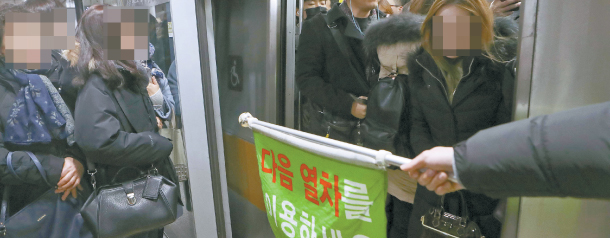Subway line No. 9 still ‘hell on wheels’

A subway employee advises passengers at Noryangjin Station on Line No. 9 to wait for the next train on Jan. 10 in southern Seoul. [OH JONG-TAEK]
Seoul Subway line No. 9, which connects northwestern and southeastern Seoul from Gimpo International Airport to Coex, is the most crowded line in Seoul, with an average usage rate of 175 percent during rush hours. That means 175 passengers for every train with a capacity of 100 passengers.
To cope better, the Seoul Metropolitan Government came up with a plan to bump up the total number of trains on the line from 41 to 45 by the end of the year.
Three trains have been upgraded from four cars to six since Dec. 30. That creates room for 104 additional passengers, 52 per car.
Fourteen more four-car trains will become six-car trains by July. Most major subway lines in Seoul operate six- to ten-car trains.
The three upgraded six-car trains run a total of 16 times during rush hour from 7 to 9 a.m. and 6 to 8 p.m., and 36 times during the off-peak hours.
Commuters say they haven’t felt much of an improvement. During rush hour, thousands of people still shove and shout at each other to squeeze into the already packed cars.
The line’s schedule may be to blame. “I heard there was an average of two six-car trains every hour, but when I went in search of them, there were no six-car trains in Noryangjin Station at 7 a.m.,” one 30-year-old office worker complained. On the current line schedule, none of the three lengthened trains pass Noryanggjin Station, a busy station with a connection to line No. 1, between 7 and 8 a.m.
The total cost of the upgrade is estimated at 161.2 billion won ($151.5 million). Some 60 percent of the expense will be paid by the Seoul Metropolitan Government, and the central government will subsidize the rest. The somewhat modest goal is to push the usage rate down from 175 to 161 percent during rush hours.
However, many are pessimistic. “Though trains operating from June should have completed their safety examinations by last December, they are still ongoing,” noted Park Gi-beom, the head of the labor union for line No. 9. “We also need to conduct a 1,000-kilometer [621-mile] test drive for public safety.”
“Even if we postpone the date of operations, we will do our best to ensure the safety of the trains,” the Seoul Metropolitan Infrastructure Headquarters said.
Line No. 9 is unique among subway lines. The Seoul Metro Line 9 Corporation, which started services in July 2009, is owned entirely by private investors. French company RATP Dev Treansdec Asia owns 80 percent while Hyundai Rotem, part of the Hyundai Motor Group, holds 20 percent.
“Given that this is a private business, the Line 9 Corporation is trying to operate as few trains as possible to save on maintenance fees and labor costs,” a researcher from the Public Policy Institute for People said. “That’s why they were not keen on employing the six-car trains initially.”
Line No. 9’s union went on strike for six days last Nov. 30 to protest long hours and lack of staff compared to lines 1 to 8. Seoul’s first eight subway lines are either operated by Seoul Metro or Seoul Metropolitan Rapid Transit, both public institutions under the Seoul city government.
BY LEE TAE-YUN AND KIM EUN-JIN [kim.eunjin1@joongang.co.kr]










with the Korea JoongAng Daily
To write comments, please log in to one of the accounts.
Standards Board Policy (0/250자)